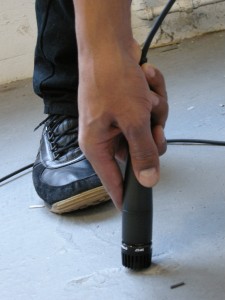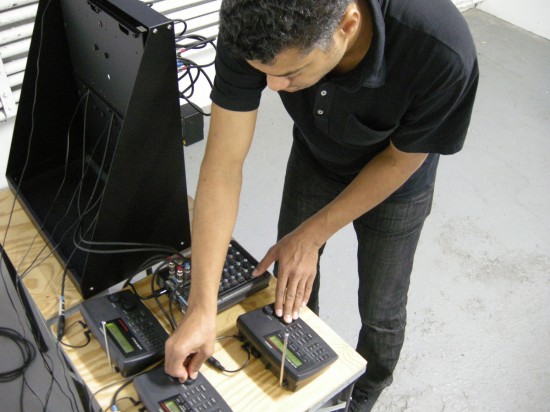Kabir Carter is a performance and installation artist based in NY. His work could be described as an eloquent study on the interactions and interpolations between sound, space and the body. I was introduced to his work while doing research for the book Transmission Arts: Artists and Airwaves and I was intrigued by the physicality of his creative method as well as his attentiveness to the spaces he uses for his work. Kabir Carter will be performing tomorrow Tuesday, October 18th, at the Transmission Arts: Artists and Airwaves book celebration at Issue Project Room.

"Report"
When did you start to develop a sensibility about space in all its different manifestations (public, private, indoors and outdoors). What was the first interaction/experiment or project that sparked this idea in your head and consequently in your work?
What set me to actively consider space in my own work was Shared Frequencies. Several years ago, I received a grant to go out on New York City sidewalks and set up a loose array of radio scanners, signal routers, and analog synthesizer modules atop a pair of folding tables. My first few realizations of the work required me to rethink my relationship to sound in space on the fly.
I determined ways to make small monitors project reflective and resonant sound that could be heard within and alongside the energizing high SPL auditory events that blanket urban locales. These and other challenges that I faced while presenting Shared Frequencies in public outdoor spaces led me to better consider architectural acoustics, and how our bodies move through sound and space.
The correlation between sound and space plays a very important role in your work. In the equation between a sounding space and a transformative sound, which of the two is more prevalent?
My use of sound requires space – or at least the idea of space as it applies to a medium – in order to be tangible and concrete. And in terms of sound, space is largely perceived by what it carries, or what demarcates it. I’m interested in how both sound and space can be shaped by transformative energies, and I look for ways to highlight how a signal chain can extend into architecture, and in and out of one’s body.
Space would need to be included in such a chain as well. So signal, space, landscape, architecture, and body would all fall along in a variably arranged series of modulated possibilities. Additionally, I feel that sound in the visual arts is at once liberated by its mutable nature, and complicated by its partially formed discursive condition – as something that historically grows out of mostly experimental music practices, and is inscribed with artists’ wholly or partly decoupling from that history and adopting trends originating from late twentieth century visual art practices. Returning to the question, such a correlation will yield very different values depending on where one chooses to stand in relation to these two histories.
Do the advances of technology corrupt our relation to our surrounding environments, the spaces we inhabit and interact with or even reality to some extend?
That’s a rather complicated question – if we are considering acoustic technology, I think it remains a concern that media technology is, historically speaking, partly bequeathed to us through the military. In this light, one might appreciate experimental music practices that are centered on what Friedrich Kittler termed the “abuse” of such technological systems. Part of media arts collective Mobile Image’s eighties era manifesto also merits repeating here: “the counterforce to the scale of destruction is the scale of communication, and… our legacy or epitaph will be determined in many ways by our ability to creatively employ informal, multimedia, multi-cultural, conversational, telecommunications and information technologies.” Today, we seem to be very much enmeshed in a struggle with and against media technology, and perhaps that is the least that we can hope for – a doubled movement with and against technology.
You have at times used radio as a source material in your installation work and performances. What is it that you find appealing in this sound source?
While I’ve mostly stopped using radio in my work, my initial attraction to it was as both a source and a site. So in Shared Frequencies, radiophonic signals and radiophonic space are both considered as performative materials that can be worked with over time. I gradually extracted bodily behaviors from my experiences with Shared Frequencies to generate a series of works that focus on how one’s body can be used to move radiophonic sound events through multiple sites or physical locations. And after working on a few projects without using radio technology, it became clear to me that my interests were more closely aligned with sound and space in general, and not so much with a particular and singular kind of signal source or set of propagating conditions. If anything, I attend to spaces that are inhabited by bodies, and among these, spaces for listening to dance music tend to excite me as a listener far more than radio does. But I do expect that I will continue to try and work with its airchain in the future.
Artist Website: kabircarter.com
Transmission Arts: Artists and Airwaves Book Launch Event: free103point9.org/events/3657




 RSS
RSS
